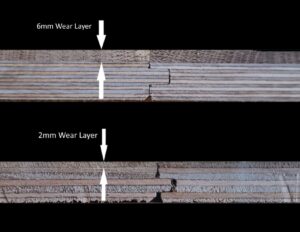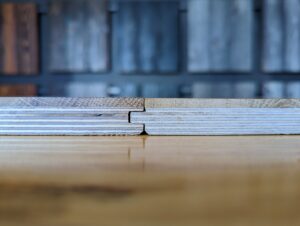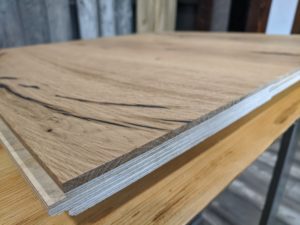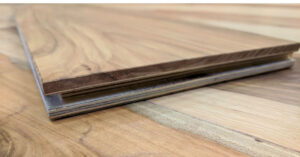How many times can you refinish an engineered hardwood floor?
Posted: October 30, 2023Click here to view our extensive line of sustainable hardwood floors.
Click here to receive a delivered price to your project.
________________________________________________________________________________________________________________________________________________
 Author – Ryan Palma Owner/CEO Sustainable Lumber Co.
Author – Ryan Palma Owner/CEO Sustainable Lumber Co.
Engineered hardwood flooring has become a popular choice for homeowners due to its durability, versatility, and stability. One of the key advantages of engineered hardwood with a thick wear layer is its ability to be refinished, which can extend its lifespan to the same as a solid wood floor. However, a common question that arises is: “How many times can you refinish engineered hardwood?” In this post, we’ll explore the answer to this question and delve into the benefits and advantages of a thick wear layer versus a thin wear layer in engineered hardwood flooring.
Understanding Engineered Hardwood Flooring
Before we discuss refinishing, let’s briefly understand what engineered hardwood flooring is. Unlike solid hardwood, which is made from a single piece of wood, engineered hardwood consists of multiple layers. The top layer, known as the wear layer is the part that you see and walk on. Beneath the wear layer are several layers of plywood, providing stability and preventing the wood from expanding or contracting significantly with changes in humidity. Understanding what this floor option is will help you in correctly choosing engineered hardwood flooring for your needs.

Refinishing engineered hardwood flooring involves sanding down the top layer (wear layer) to remove imperfections, scratches, stains, dings, or dents. After sanding, a new finish is applied to restore the floor’s original beauty. The number of times you can refinish engineered hardwood flooring depends primarily on the thickness of the wear layer.
Advantages of a Thick Wear Layer
- Multiple Refinishing Opportunities: Thick engineered wood flooring has a wear layer of 4mm-6mm thick. It can be refinished multiple times. This means you can refinish the floor’s appearance and extend its life, making it a long-lasting investment. Engineered hardwood floors with a 6mm thick wear layer can be refinished as many times as a solid wood floor, which is typically up to 10 times depending on the amount you are sanding off.
- Durability: A thicker wear layer provides extra protection against wear and tear. It can withstand heavy foot traffic, making it suitable for high-traffic areas in your home or commercial space.
- Resale Value: Homes with engineered hardwood flooring with a thick wear layer often have a higher resale value. Prospective buyers appreciate the potential for future refinishing, which adds to the overall value of the property since hardwood flooring can be very expensive and difficult to replace.
- Scratch Resistance: Thicker wear layers are less prone to scratches, which is especially advantageous for households with pets or active children.
Advantages of a Thin Wear Layer
Cost-Effective: Engineered hardwood with a thin wear layer (under 4mm) is generally more budget-friendly upfront. Many engineered floors only have a 1mm or 2mm thick wear layer, so there is a very minimal amount of actual hardwood, and is constructed of mostly plywood.
- Lighter Weight: Thinner wear layers make the flooring lighter since the overall thickness of the floor is typically 3/8″ thick. This can be advantageous for certain installations, such as on upper floors or multi-story buildings.
- Suitable for Low Traffic Areas: Engineered hardwood with a thin wear layer can be ideal for areas with minimal foot traffic, where the need for refinishing may be less frequent. An engineered hardwood floor with a 1mm or 2mm wear layer can only be refinished between one and three times during its lifespan.
Choosing the Right Wear Layer Thickness

Conclusion
Engineered hardwood flooring offers homeowners the opportunity to enjoy the beauty of the wood while benefiting from its durability and refinishing capabilities. When considering how many times you can refinish an engineered hardwood floor, the wear layer thickness is a critical factor to keep in mind. While a thick wear layer provides numerous refinishing opportunities and added durability, a thin wear layer can be a cost-effective solution for less demanding spaces. Ultimately, your choice should align with your preferences and the demands of your home.
Our knowledgeable and educated staff is here to answer any additional questions you may have. Please call us today for a free quote: Ph# 406.642.7120 or click here to submit an inquiry online. We look forward to working with you on your next project!

